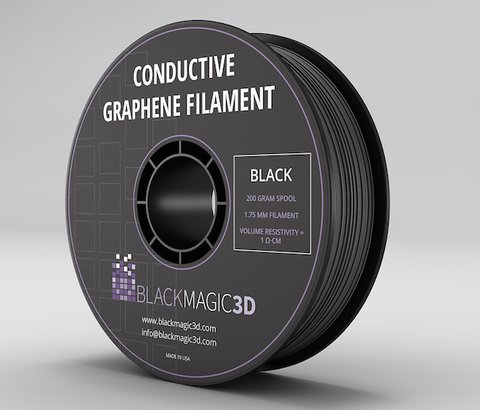3D Printing With Graphene - A Material for the 21st Century
Graphene is the thinnest material on earth with exceptional properties that make it incredibly versatile. The ‘2D material’ is a great conductor, can be as tough as a diamond, 200 times stronger than steel and as flexible as rubber.
Graphene was discovered in Manchester by Prof. Andre Geim and Prof. Kostya Novoselov during one of their frequently held scientific “Friday night experiments” – a tradition which is apparently still going strong at the University of Manchester today. During a simple experiment with a lump of graphene and sticky tape, the two noticed they were able to separate graphite fragments into flakes just one atom thick. Their findings were first published in 2003 but it wasn’t until 2004 that global interest in this curious material was truly sparked.
Dubbed Graphene City, Manchester is the home of graphene so it seems fitting that researchers at Manchester Metropolitan University (MMU) have set out to develop a 3D printer and a process to enable the construction of 3D objects with the material. Toby Heys, Digital Research Fellow and Media Research Centre Leader at MMU, has partnered with Dr. Craig Banks, Reader in Nano and electrochemical technology, and Prof. Peter Kelly, Professor of Material Science at MMU, to develop a new approach to 3D printing graphene. It’s very much a collaborative effort and Tony’s interest in the material is uniquely focused on art-based projects rather than straightforward engineering.
“My interest in developing a 3D printer and process for 3D printing graphene comes from producing interactive tactile surfaces and environments for robotic sculptures for exhibitions in museums, galleries, and biennials,” Toby explained. “I currently use ABS plastic in 3D printers but require materials that offer greater strength and conductivity.”
A complex material
Toby started researching graphene’s properties back in 2012 and later met with Banks and Peter Blake from Graphene Industries where a focus on the possibilities for artists, designers and scientists led to a KEIF R&D grant from MMU. This is where their first 3D printer was born, the ‘Gbot’. Soon after, the project led a successful application to the EPSRC to; develop a novel and advanced bottom-up fabrication route to produce graphene 3D architectures, study their properties, develop UV curable 3D printable graphene inks and demonstrate relevant applications.
GBot graphene 3D printer.
The complexity of 3D printing with graphene comes from the necessity to manipulate it into a usable material that can be controlled. The starting material has a fluffy powder-like property and this requires special processes to incorporate into manageable polymers.
Toby explained: “The requirement is to be able to incorporate polymers with suitable nanofillers that can be polymerised/cured in-situ following printing, such that another layer can be rapidly applied and so on. This will allow structures to be built without recourse to curing in an oven after each layer, as is currently the case and will significantly increase throughput/fabrication times.”
The current limitations of graphene are in the need to manipulate and regulate its architecture in order to maintain benefits and apply it to long-term applications. Right now the challenge is finding a suitable carrier to blend graphene with in the 3D printing process in order for it to truly become fundamental of 21st Century manufacturing.
An important breakthrough
Graphene has undergone significant development in the 3D printing space in the last couple of years. Since launching in 2014, US-based Graphene 3D Lab has gone from strength to strength doubling its production capacity, securing major partnerships, unveiling its 3D printed graphene battery technology and successfully releasing Conductive Graphene Filament onto the market.
Speaking to TCT back at RAPID 2015, Co-founder Dr. Elena Polyakova revealed plans for the company’s own 3D printer which will allow users to combine different materials in a single part and relinquish the limitations of current FDM technology.
“It is likely to become one of key materials in functional 3D printing,” Elena explained. “Graphene enhanced polymers are great conductors of electricity. We will need many different materials to print optical elements, energy storage devices, transistors, etc. Graphene composites can be adapted for many of these elements. Needless to say, speed and accuracy of deposition techniques must be improved. The next generation of hardware that can print with dozens of materials must be created.”
That’s where research projects such as that at MMU and hardware plans at Graphene 3D Lab will provide the necessary foundations for progressing the technology as a manufacturing material for real functional items like smart products, micro batteries, super and ultra-graphene capacitors and solar devices.
Toby commented: “Having the capacity to 3D print with graphene will be an important breakthrough in the evolution of printing very strong lightweight materials. More specifically, in terms of our current research project it will allow a next-generation additive manufacturing technology to be developed that allows graphene to be rapidly printed into a range of useful 3D structures.”
What’s next?
Graphene is still very much in its infancy but researchers expect its presence to be pivotal in changing the way we travel, develop medical equipment and deliver system and tackle issues such as water purification. As Toby puts it, regardless of the type, “there needs to be patience” if Graphene is to be fully understood and developed.

National Graphene Institute in Manchester.
Last month, a PhD student at the University of Manchester became the recipient of the annual Eli and Britt Harari Graphene Enterprise Award for a business proposal to develop a range of graphene based inks for printed electronics. Daryl McManus impressed judges with a business proposal demonstrating the depositing of graphene in more consistent and environmentally friendly ways. The £50k prize money will be used to found a new graphene start-up company that will harness graphene’s properties for applications in printed electronics.
With the recent launch of the National Graphene Institute, a £61m world leading facility for graphene research in Manchester, the possibilities for this revolutionary material have never been more promising for researchers and graphene start-ups setting up camp in graphene’s place of origin.





